Intel Dual Core Performance Preview Part I: First Encounter
by Anand Lal Shimpi on April 4, 2005 2:44 PM EST- Posted in
- CPUs
Business Application Performance
Business Winstone 2004
Business Winstone 2004 tests the following applications in various usage scenarios:- Microsoft Access 2002
- Microsoft Excel 2002
- Microsoft FrontPage 2002
- Microsoft Outlook 2002
- Microsoft PowerPoint 2002
- Microsoft Project 2002
- Microsoft Word 2002
- Norton AntiVirus Professional Edition 2003
- WinZip 8.1
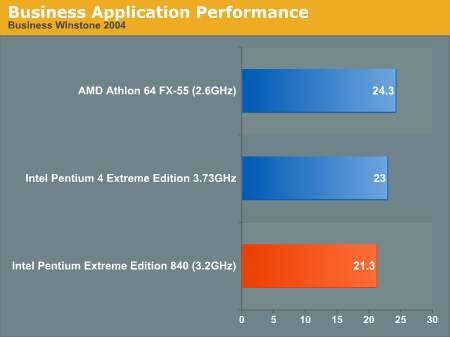
There's no surprise here - your best business application performance is going to come from a very fast single core CPU.
Office Productivity SYSMark 2004
SYSMark's Office Productivity suite consists of three tests, the first of which is the Communication test. The Communication test consists of the following:"The user receives an email in Outlook 2002 that contains a collection of documents in a zip file. The user reviews his email and updates his calendar while VirusScan 7.0 scans the system. The corporate web site is viewed in Internet Explorer 6.0. Finally, Internet Explorer is used to look at samples of the web pages and documents created during the scenario."

The next test is Document Creation performance:
"The user edits the document using Word 2002. He transcribes an audio file into a document using Dragon NaturallySpeaking 6. Once the document has all the necessary pieces in place, the user changes it into a portable format for easy and secure distribution using Acrobat 5.0.5. The user creates a marketing presentation in PowerPoint 2002 and adds elements to a slide show template."
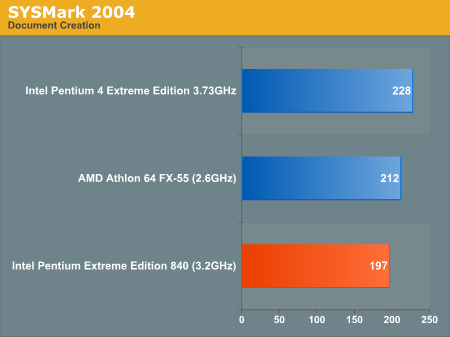
The final test in our Office Productivity suite is Data Analysis, which BAPCo describes as:
"The user opens a database using Access 2002 and runs some queries. A collection of documents are archived using WinZip 8.1. The queries' results are imported into a spreadsheet using Excel 2002 and are used to generate graphical charts."
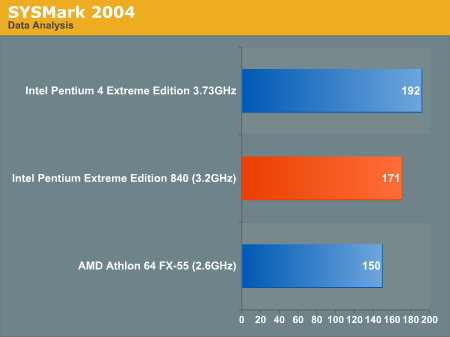
The Office Productivity SYSMark 2004 suite shows some benefit to dual core, given that there is quite a bit of multitasking involved in the test suite. Despite the multitasking, the Pentium Extreme Edition running at 3.2GHz isn't able to trounce its single core 3.73GHz relative.
Business Winstone 2004 includes a multitasking test as a part of its suite, which does the following:
"This test uses the same applications as the Business Winstone test, but runs some of them in the background. The test has three segments: in the first, files copy in the background while the script runs Microsoft Outlook and Internet Explorer in the foreground. The script waits for both foreground and background tasks to complete before starting the second segment. In that segment, Excel and Word operations run in the foreground while WinZip archives in the background. The script waits for both foreground and background tasks to complete before starting the third segment. In that segment, Norton AntiVirus runs a virus check in the background while Microsoft Excel, Microsoft Project, Microsoft Access, Microsoft PowerPoint, Microsoft FrontPage, and WinZip operations run in the foreground."
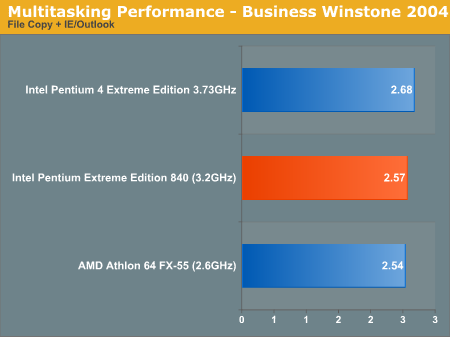
The performance of the dual core Extreme Edition comes within 5% of the 3.73GHz EE, despite the fact that the single core chip has a 16% clock speed advantage, but it is still slower overall.
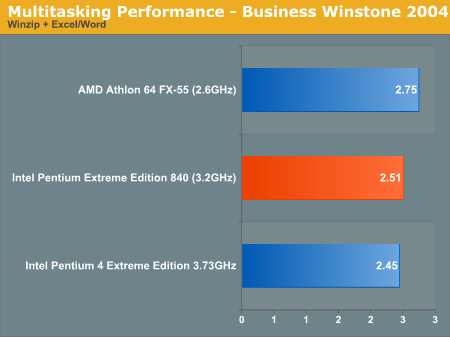
The second test finally shows something positive for the dual core chip, with a negligable 2% performance lead. This is the perfect example of how multi-core can be a substitute for clock speed when it comes to performance. Note that despite the Pentium Extreme Edition being faster than the 3.73EE, the single core Athlon 64 FX-55 is faster than both.

The third and final test also shows a slight performance advantage for the dual core Extreme Edition, even over the Athlon 64 FX-55.
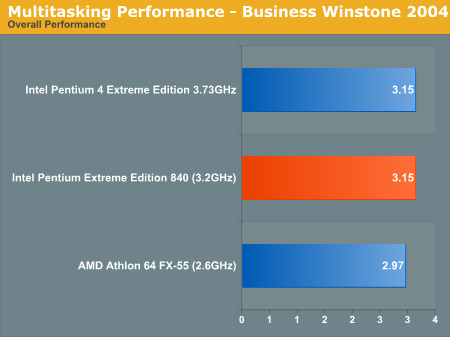










141 Comments
View All Comments
johnsonx - Monday, April 4, 2005 - link
It looks like AMD better get busy. AMD woke up Intel from it's complacent slumber, and now Intel is going to start eating AMD's lunch. AMD has completely lost the 64-bit advantage, and will now lose whatever dual-core advantage it had by designing Hammer to be dual-core from the start. Prescott may or may not have been designed for dual-core, but it sure seems to work just fine, doesn't it?AMD's problem is that it talks about what it's going to do for too long before actually doing it, as if there isn't anything Intel can do about it. Intel surely can do something about it, and definitely has. This may be an obvious consequence of being a much smaller company: AMD doesn't have the resources to get things done as quickly as Intel can (when Intel is sufficiently motivated), but that just means AMD needs to keep their mouths shut for longer. AMD has been relegated to 'me-too' status for technologies they themselves were first with...
Object lesson for AMD: Intel can beat you to any launch date you set for any technology or feature you think you've got an exclusive on. Intel can then crush you with volume and market presence. It ain't fair... welcome to life.
AMD's best bet: whatever you set your launch dates to, surprise launch everything 6 months ahead of schedule. That'll only work a couple of times, but it's better than nothing.
Klober - Monday, April 4, 2005 - link
Two separate points here:First, I suppose dual-core may not improve single threaded application performance much over a single-core CPU with HT, but shouldn't it increase performance over a single-core CPU w/o HT? I would think it would allow the OS to run on one core while the application runs on the other core, which in theory should increase performance some. Just a thought, as I'm no expert on scheduling and the resources the OS actively requires.
Second point, a small simple application that may be useful in benchmarking, particularly in multitasking benchmarks, might be Macro Scheduler by MJT Net. It takes very little in the way of resources, and is very easy to program for starting applications, switching between them, taking screenshots, clicking on options and even typing whatever you'd like wherever you'd like. I think it could be a great base for switching between applications and starting processes inside those applications, all in a very repeatable manner. Timing can be down to the 1/10,000th of a second if need be, and using a scheduler with minimal resource impact would take the human element out of the benchmarking. Maybe you've already looked into this, or something similar, but it's just a thought that may make certain benchmarking situations easier for all of you that bring us these great (p)reviews.
Googer - Monday, April 4, 2005 - link
In Soviet Russia you post all you bad jokes Here:http://forums.anandtech.com/messageview.aspx?catid...
knitecrow - Monday, April 4, 2005 - link
yo dog, where the temperature at?but seriously, in addition to the usual suspects, I think anandtech should have compared pentium D to xenon 3.2ghz just to see the performance difference.
johnsonx - Monday, April 4, 2005 - link
ok, sorry... I posted my comment before reading the encoding benchmarks, where I see you did exactly what I suggested. My bad.vaystrem - Monday, April 4, 2005 - link
"2) Open iTunes and start playing the latest album of avid AnandTech reader 50 Cent on repeat all."? Really?
johnsonx - Monday, April 4, 2005 - link
I know it's nearly double the number of benchmarks to run, but it would have been instructive to see both Pentium processors benchmarked without HT as well. Testing the dual-core pentium EE without HT would of course mimic a 3.2Ghz Pentium D, and testing the single core P4 without HT would give us a baseline single-core, single execution thread reference.Finally, it might also be instructive to benchmark current P4 at 3.2Ghz, again both with and without HT.
Easy for me to say, I know, since I'm not the one who has to do all the benches....
LeadFrog - Monday, April 4, 2005 - link
I like the theory of if it can't get any faster lets just combine a few.SLI, RAID, and Dual Core CPU's.
segagenesis - Monday, April 4, 2005 - link
One site mentioned 125W power consumption. Ow.Well, its a start... but I want to see AMDs offering first.
msva124 - Monday, April 4, 2005 - link
This looks promising, I wonder if AMD might eventually cave and implement hyper-threading in their processors, in addition to dual core. Or is that not part of the cross licensing agreeement?